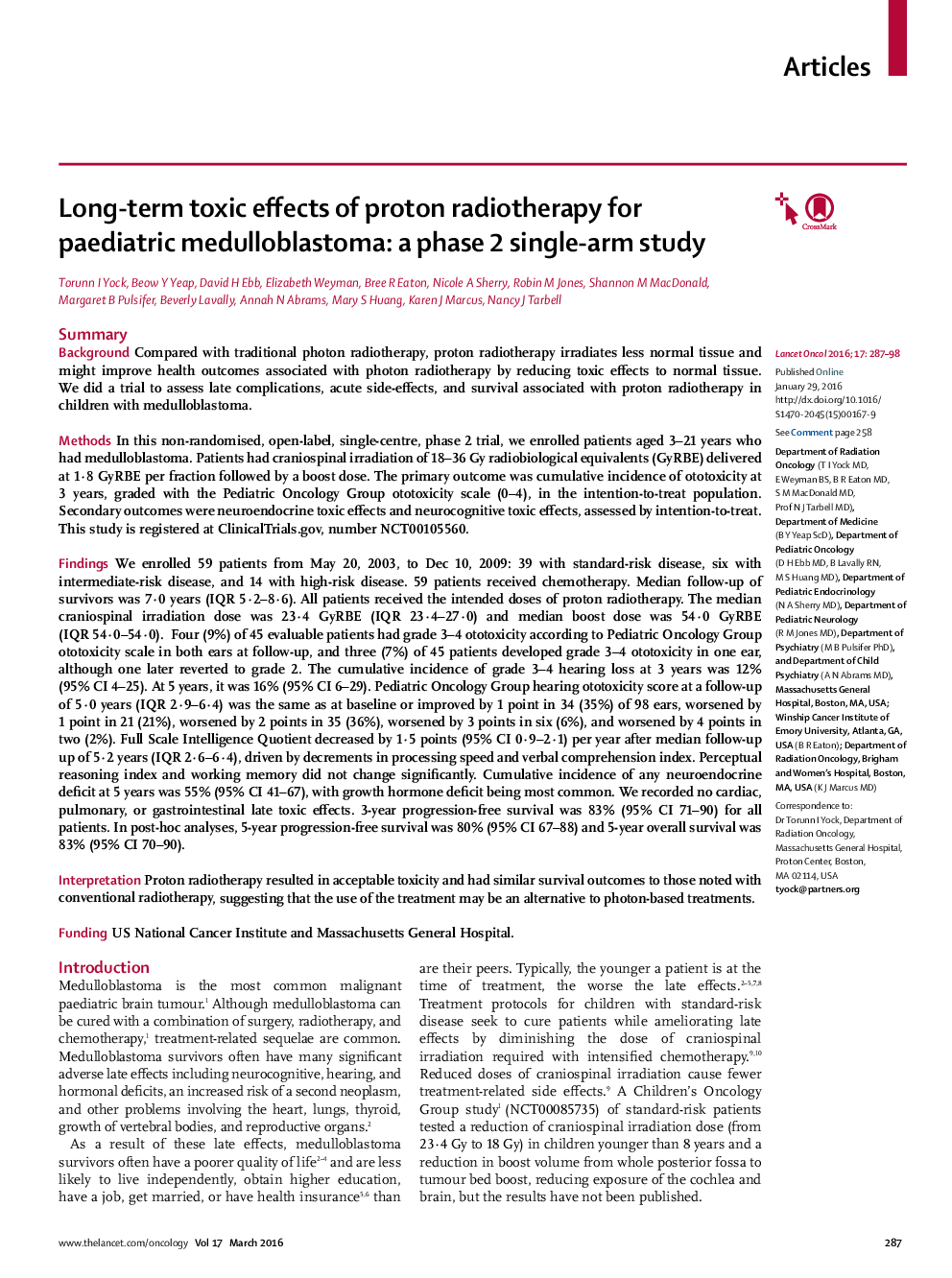| Article ID | Journal | Published Year | Pages | File Type |
|---|---|---|---|---|
| 3993355 | The Lancet Oncology | 2016 | 12 Pages |
SummaryBackgroundCompared with traditional photon radiotherapy, proton radiotherapy irradiates less normal tissue and might improve health outcomes associated with photon radiotherapy by reducing toxic effects to normal tissue. We did a trial to assess late complications, acute side-effects, and survival associated with proton radiotherapy in children with medulloblastoma.MethodsIn this non-randomised, open-label, single-centre, phase 2 trial, we enrolled patients aged 3–21 years who had medulloblastoma. Patients had craniospinal irradiation of 18–36 Gy radiobiological equivalents (GyRBE) delivered at 1·8 GyRBE per fraction followed by a boost dose. The primary outcome was cumulative incidence of ototoxicity at 3 years, graded with the Pediatric Oncology Group ototoxicity scale (0–4), in the intention-to-treat population. Secondary outcomes were neuroendocrine toxic effects and neurocognitive toxic effects, assessed by intention-to-treat. This study is registered at ClinicalTrials.gov, number NCT00105560.FindingsWe enrolled 59 patients from May 20, 2003, to Dec 10, 2009: 39 with standard-risk disease, six with intermediate-risk disease, and 14 with high-risk disease. 59 patients received chemotherapy. Median follow-up of survivors was 7·0 years (IQR 5·2–8·6). All patients received the intended doses of proton radiotherapy. The median craniospinal irradiation dose was 23·4 GyRBE (IQR 23·4–27·0) and median boost dose was 54·0 GyRBE (IQR 54·0–54·0). Four (9%) of 45 evaluable patients had grade 3–4 ototoxicity according to Pediatric Oncology Group ototoxicity scale in both ears at follow-up, and three (7%) of 45 patients developed grade 3–4 ototoxicity in one ear, although one later reverted to grade 2. The cumulative incidence of grade 3–4 hearing loss at 3 years was 12% (95% CI 4–25). At 5 years, it was 16% (95% CI 6–29). Pediatric Oncology Group hearing ototoxicity score at a follow-up of 5·0 years (IQR 2·9–6·4) was the same as at baseline or improved by 1 point in 34 (35%) of 98 ears, worsened by 1 point in 21 (21%), worsened by 2 points in 35 (36%), worsened by 3 points in six (6%), and worsened by 4 points in two (2%). Full Scale Intelligence Quotient decreased by 1·5 points (95% CI 0·9–2·1) per year after median follow-up up of 5·2 years (IQR 2·6–6·4), driven by decrements in processing speed and verbal comprehension index. Perceptual reasoning index and working memory did not change significantly. Cumulative incidence of any neuroendocrine deficit at 5 years was 55% (95% CI 41–67), with growth hormone deficit being most common. We recorded no cardiac, pulmonary, or gastrointestinal late toxic effects. 3-year progression-free survival was 83% (95% CI 71–90) for all patients. In post-hoc analyses, 5-year progression-free survival was 80% (95% CI 67–88) and 5-year overall survival was 83% (95% CI 70–90).InterpretationProton radiotherapy resulted in acceptable toxicity and had similar survival outcomes to those noted with conventional radiotherapy, suggesting that the use of the treatment may be an alternative to photon-based treatments.FundingUS National Cancer Institute and Massachusetts General Hospital.
